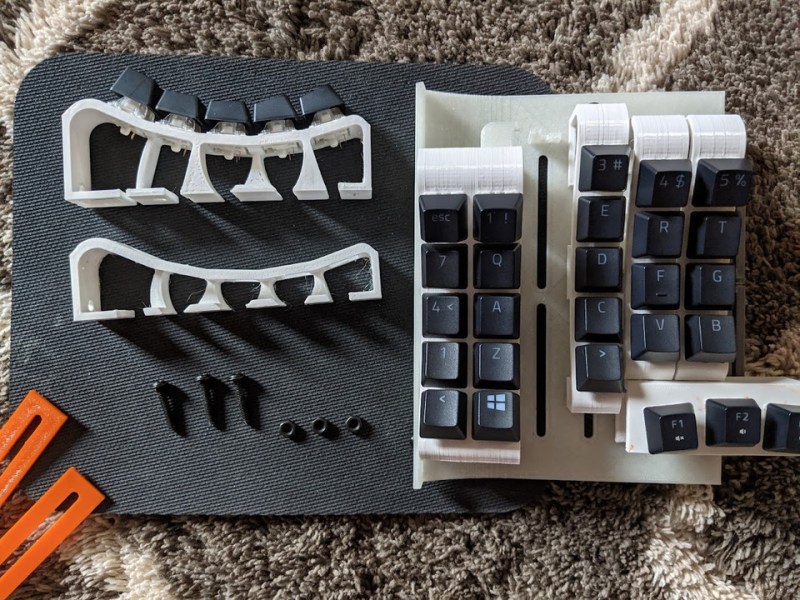Have you been wanting to build your own keyboard, ergonomic or otherwise, but are hesitant to spend all that time and filament on something that may not be a good fit for your hands? Glad as we are that the dactyl is open-source, to get in there and really mess around with it requires intimate knowledge of either OpenSCAD or Clojure.
Well, not anymore. [WolfIcefang]’s dactyl chimera is an ergo sandbox, a test bench for column curvature, stagger, and height that should keep you from having to iterate all day and night. It was designed in FreeCAD and has three parts — the rack, the tenting foot, and the arches. The rack acts like a bottom plate and has slots for holding the columns (arches) in place. Underneath that is the tenting foot, which changes the lateral inclination. Thirdly are the arches, the business part where the switches go.
[WolfIcefang] says it’s sturdy but not portable, and for some reason feels the need to apologize for the looks. We think it’s beautiful, but then again are easily captivated by such practicality. It’s not quite a keyboard yet, as [WolfIcefang] has neither wired it up nor burned in any firmware. This is still in the early stages, and [WolfIcefang] wants to open it up to collaborators. Plans for the future include interchangeable thumb clusters and a complete build guide.
Even if you aren’t that fluent in OpenSCAD, you’ll have fun messing around on the keycap modeling playground.
















Well frankly I would much much rather work in OpenSCAD than FreeCAD anyday. And I really mean it.
But I can take the inverse of this article as a tip that a bunch of keyboard related work has already been done using OpenSCAD, so I will take a look around. Thanks!
Me, I bought into (literally) an Ergodox EZ, but if there is work in the realm of alternate keycaps … well, I’ll take a look.
I’m curious as to what you think is wrong with Freecad. I used it extensively for the creation of 3d part models with which I illustrated an entire book.
http://hpfriedrichs.com/mybooks/mmm/bks-mmm-gallery1.htm
Learning curve? Definitely. But with most pieces of powerful software, what you get out of it is proportionate to what you’re willing to put in.
I am routinely amazed at how a competent Photoshop user, for example, can restore to pristine condition an old photo with stains, tears, and holes (where a portion of a face might actually be missing!)
What he can accomplish might as well be magic, but this much I’m sure of– simply purchasing a copy of the software would not qualify me to do the same. It would take a significant investment of my time to learn the tools and work flow.
And should it prove difficult for me master that task, is that Photoshop’s fault or mine?
I have tried to into FreeCAD multiple times in the past two years, especially once I got a 3d printer, but it feels like I’m bashing my head on a wall even trying to directly follow along with tutorials. I can’t internalize what the taskflow is, or something
Iirc freecad actually uses openscad as it’s backend. So I strongly suspect (but haven’t checked) that one can get it to spit out openscad. It probably won’t be the prettiest code (a la any generated code not meant for human consumption), but could probably serve as a good starting point.
Freecad has its own thing, but it’ll take openscad files as inputs.
https://wiki.freecadweb.org/OpenCASCADE
(Oh, that’s a confusingly similar name…)
What you want is cadquery, which is a python-based “openscad-y thing” which *does* use the same backend as freecad.
All of this is useful stuff! I had no idea FreeCAD used OpenSCAD as a backend.
It is simple for me. I was trying different software to do a simple experiment (my benchmark) putting a round hole of a certain diameter in a certain location. I never could get FreeCAD to do it, there was this whole concept of constraints and I just wanted to say, “put it here, and use this radius”. It was trivial with OpenSCAD.
But I am a programmer and OpenSCAD is what I do .. write code. Easy peasy.
it doesn’t. it’s openCASCADE, as mentioned above. Using openSCAD as core wouldn’t make any sense for a CAD system, as it can’t produce/create simple perfect entities like circles. Those are triangulated in the first place and this aren’t of any use for the real world (machining, sharing files with other CAD software) outside of 3D printing.
I think it is a great idea.
That said (written), I would like to know more about how the key switches and their associated wiring will be implemented.
I’m especially excited about the prospect of a DIY ergonomic split keyboard that still has function keys, arrow keys, and home/end/pgup/pgdn keys.
Yes, I tried the layer-based approach. No, I just can’t do it.
A nice winter vacation project for me! This is exactly what I’ve been looking for. (Long-time Kinesis Advantage user.) I’m going to drop the deck height to be as low as possible, and tighten up the key pitch; then it should be just about perfect for me. As others have said, I’m planning on adding 6-12 function keys for media control and common macros. Also will probably slap a Qi charger in there for the phone, headphones, etc.